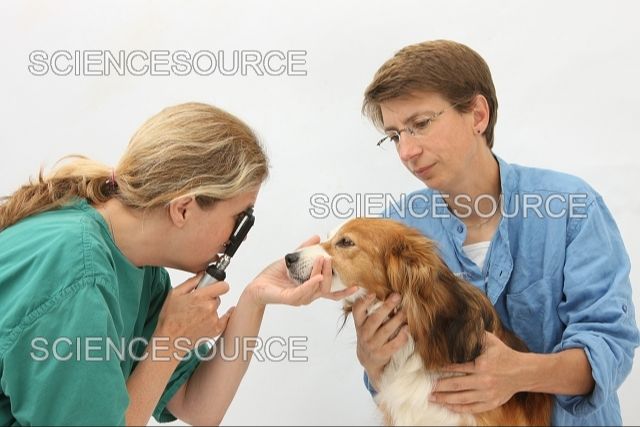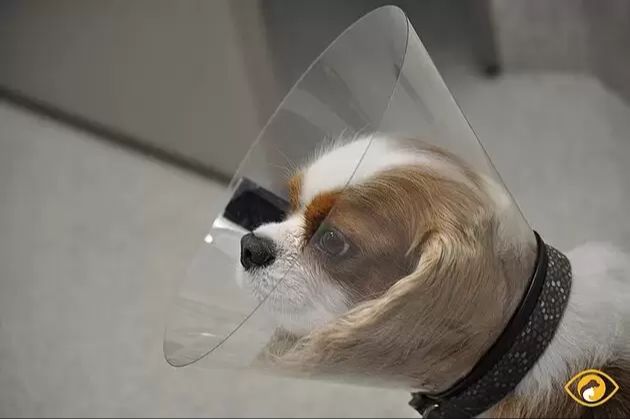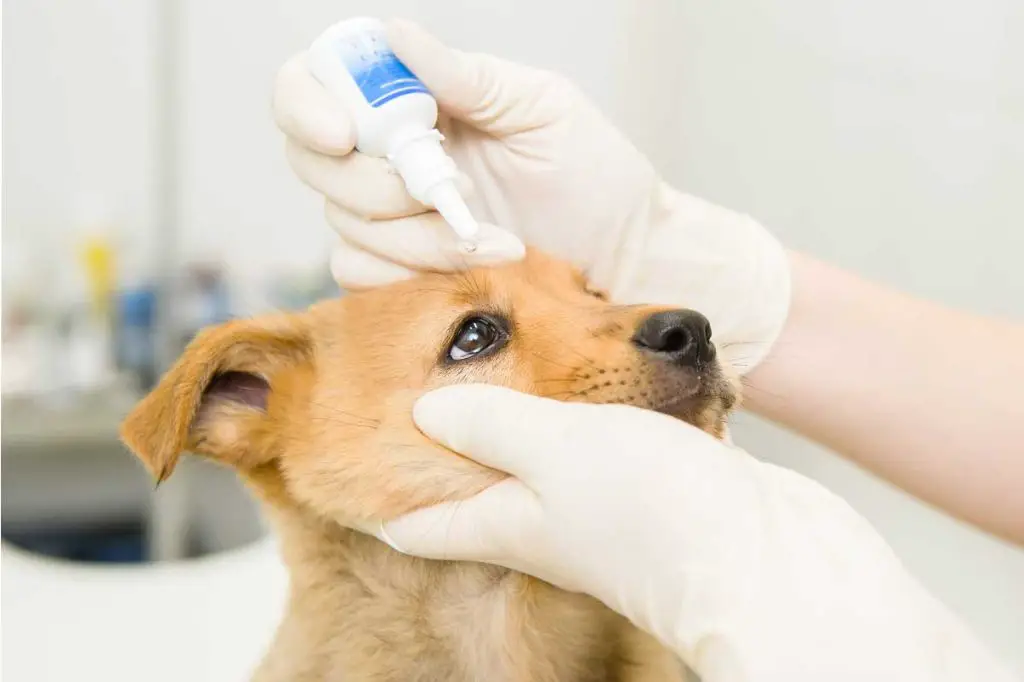What is strabismus (cross eye) in dogs?
Strabismus, also known as cross eye, is a condition in dogs where the eyes are not properly aligned with each other. One or both of the eyes turn either inward (towards the nose) or outward (towards the ears). This misalignment of the eyes prevents them from working together as a pair.
With strabismus, the dog’s brain receives two different images from each eye rather than a single unified image. This can lead to vision problems, eye strain, headaches, and dizziness in dogs with this condition.
Strabismus is caused by abnormalities with the muscles that control eye movement or the nerves controlling these muscles. Certain injuries, underlying illnesses like canine distemper, and genetics can contribute to nerve or muscle issues resulting in strabismic eyes.
Signs and Symptoms
There are several signs and symptoms that may indicate a dog has strabismus or cross eyes. The most obvious sign is the appearance of the eyes themselves. One or both eyes may turn either inward (towards the nose) or outward (towards the ears). The eyes may not appear to be looking in the same direction. This misalignment of the eyes is the hallmark sign of strabismus.
Vision problems often accompany cross eyes in dogs. The dog’s depth perception may be affected, causing them to misjudge distances or bump into objects. Their vision may be blurred or double. There may be limited movement of the eyes in the affected direction. The dog may tilt their head or have trouble seeing toys or treats.
A lack of coordination or clumsiness can also indicate an issue with vision and eye alignment. The dog may have trouble navigating stairs or judging spaces. They may be hesitant to jump up or down. Instability and stumbling may occur more frequently.
In summary, the signs and symptoms of strabismus or cross eyes in dogs include: misaligned eyes looking in different directions, vision problems like blurred or double vision, head tilting, and lack of coordination or clumsiness.
Diagnosing strabismus

If you notice signs of strabismus in your dog, the next step is to take your dog to the veterinarian for a diagnosis. The vet will perform a full eye exam to evaluate your dog’s vision and how well its eyes work together.
Some of the tests the veterinarian may conduct include:
- Observing how your dog’s eyes move – checking for misalignment, rapid eye movements, or inability to focus.
- Measuring tear production.
- Using drops to dilate your dog’s pupils and examine the inner structures of the eyes.
- Testing reflexes by blinking lights in your dog’s eyes to observe responses.
- Looking for swelling or infection.
- Measuring pressure inside the eye.
- Performing vision testing to see if your dog can follow objects and perceive depth.
These tests help determine the cause and extent of the strabismus. The vet can then recommend the appropriate treatment options.
Treatment Options for Strabismus in Dogs
If your dog is diagnosed with strabismus, there are both surgical and nonsurgical treatment options available. The appropriate treatment will depend on the underlying cause and severity of your dog’s condition.
Nonsurgical Options
For mild cases of strabismus, your veterinarian may recommend a trial of nonsurgical options first. This can include:
- Eye exercises – Specific eye movement exercises may help strengthen the eye muscles and improve alignment.
- Eye patches – Covering the properly aligned eye can force the misaligned eye to work harder and potentially improve its function.
- Medications – Certain medications like corticosteroids may help with inflammation or other underlying issues contributing to strabismus.
Surgery

If nonsurgical options are ineffective, surgery may be recommended. Common surgical procedures include:
- Eye muscle shortening/lengthening – The eye muscles controlling movement are surgically tightened or loosened to allow the eye to move properly.
- Eye muscle reattachment – Detached eye muscles can be reattached to the eye wall.
- Eye muscle repositioning – The points at which eye muscles connect to the eye can be adjusted.
Surgery is performed under general anesthesia. Recovery time is typically a few weeks, with restrictions on activity to allow the surgical site to heal.
Success Rates
With appropriate treatment, many dogs with strabismus can regain good vision and eye alignment. However, recurrence is common. Lifelong monitoring and follow-up care with your veterinarian is recommended.
For dogs with neurological or structural abnormalities causing strabismus, treatment may only provide partial improvement. But even incremental progress can make a big difference in your dog’s comfort and quality of life.
Surgical procedures
There are different surgical procedures that can be performed to correct strabismus in dogs. The specific type of surgery will depend on the underlying cause and severity of the condition.
Some common surgical procedures include:
- Recession: This involves detaching and repositioning one or more extraocular muscles that control eye movement. It helps realign the misaligned eye.
- Resection: This removes a small portion of an extraocular muscle to reduce its ability to pull the eye in that direction. This helps correct deviations.
- Transposition: This detaches and reattaches an extraocular muscle to a new location. It creates a net shift in eye alignment.
The surgery is performed under general anesthesia. The veterinary ophthalmologist will make a small incision on the side of the eye to access the muscles. The specific muscles involved will depend on which direction the eye is deviating. Stitches may be placed to close the opening.
After surgery, dogs will need to wear an Elizabethan collar to prevent rubbing and allow the incision site to heal. Medications like anti-inflammatories and antibiotics may be prescribed. Follow up appointments will monitor healing and progress.
It can take 4-8 weeks to see the full results of strabismus surgery in dogs. Most dogs recover well with improved eye alignment. However, some cases may require additional procedures if alignment is still not adequate.
Nonsurgical Options
For mild cases of strabismus in dogs, vets may recommend trying nonsurgical treatment options first before considering surgery. Some common nonsurgical approaches include:
Eye Exercises
Certain eye exercises can help strengthen the muscles around the eye and improve alignment. For example, your vet may have you hold a toy or treat in front of your dog’s face and have them follow it side to side or up and down. Repeating these simple eye tracking exercises daily can help train the eyes to work together.
Vision Therapy
Vision therapy is a specialized program designed by a veterinary ophthalmologist to improve eye alignment and coordination. It involves a regimen of daily eye exercises, activities, and games tailored to your dog’s needs. These can help strengthen eye muscles, enhance focus, and stimulate normal eye teaming.
Medication
Oral medication or eye drops may be prescribed to encourage the eye muscles to straighten. These medications are usually anticholinesterases, which can help correct misalignment in some cases of acquired strabismus. However, medication is not commonly used as a sole treatment for strabismus in dogs.
Prognosis
The prognosis for dogs with strabismus depends on the underlying cause and the treatment plan. In cases of acquired strabismus due to trauma, inflammation, or a disorder, the prognosis is generally good if treated early before permanent changes occur in the eye muscles or vision development. With prompt treatment such as anti-inflammatory medication, ointments, or rest, acquired strabismus can resolve within a few days to weeks in many dogs.

For dogs with congenital strabismus present from birth, the prognosis is more variable. Surgical correction at a young age often has an excellent prognosis for realigning the eyes and preventing amblyopia or lazy eye. However, there is a risk of recurrence, especially in breeds predisposed to strabismus. Close monitoring and follow-up care is important. Dogs with small-angle strabismus may have a good functional prognosis without surgery, but often have a cosmetic defect. Overall the likelihood of successful treatment is highest with early intervention, but strabismus can reoccur in some dogs later in life.
Living with a dog with strabismus
Having a dog with strabismus can require some adjustments to your care routine and considerations for your dog’s quality of life. While the condition may not be curable, dogs can often adapt well.
Ongoing care is needed to manage symptoms and prevent complications. Your vet may recommend ongoing medications, such as eye drops or injections, to reduce inflammation and prevent worsening of the condition. Regular eye exams will be required to monitor for any changes.
You may need to take some extra precautions around the home to ensure your dog’s safety and prevent injuries. Use baby gates to block off stairs or other fall risks. Be mindful of potential eye injuries from objects at your dog’s eye level. Keep areas clear of clutter.
Providing a consistent, safe environment can help your dog confidently navigate their surroundings. Keep food and water bowls in the same spot and avoid abruptly moving furniture. Consider providing ramps or steps to your dog’s favorite spots.
While strabismus may impact your dog’s depth perception or field of vision, most dogs adapt remarkably well. Your dog can still live a happy, fulfilling life with this condition. Stay positive and reward small successes as your dog adjusts. Focus on their abilities, not their disability. With your loving care and patience, you and your dog can manage strabismus together.
Prevention
There are some steps dog owners can take to help prevent strabismus in their pets:
Breeding Recommendations
Responsible breeders should screen breeding dogs for eye issues like strabismus and only breed dogs with healthy eyes. Certain breeds like Boston Terriers, Pugs, and English Bulldogs are more prone to strabismus, so extra care should be taken when breeding these dogs. Reputable breeders will have documentation from a veterinary ophthalmologist confirming their breeding dogs are free from inherited eye diseases.
Injury Prevention

While some cases of strabismus are congenital, injury can also cause dogs to develop a turned eye. Be sure to puppy-proof your home by removing hazards and supervise playtime to prevent injuries. Use a harness instead of a collar when walking to avoid damaging the eyes or nerves in the neck if your dog pulls. Don’t let your dog stick its head out the window of a moving car. Keep areas clean and avoid small, dangerous objects your pet could swallow. Take care not to overfeed leading to obesity, as excess weight can increase eye pressure.
When to seek help
It’s important to monitor your dog’s eyes and vision closely. Seek immediate veterinary care if you notice any of the following red flags or emergencies:
- Sudden onset of strabismus in an adult dog
- Ocular discharge or inflammation
- Rubbing or pawing at the eyes
- Squinting or keeping the eyes closed
- Cloudiness in the eye
- Enlarged or dilated pupils
- Bumping into furniture or walls
- Difficulty seeing toys or food
- Walking in circles or tilted head
- Loss of vision
- Eye injury or trauma
- Eyelid swelling or drooping
- Eye bulge or proptosis
These signs can indicate a serious underlying condition requiring rapid veterinary intervention. Left untreated, some eye issues like glaucoma or lens luxation can lead to permanent blindness. So if your dog displays any concerning ocular symptoms, don’t delay seeking emergency vet care.